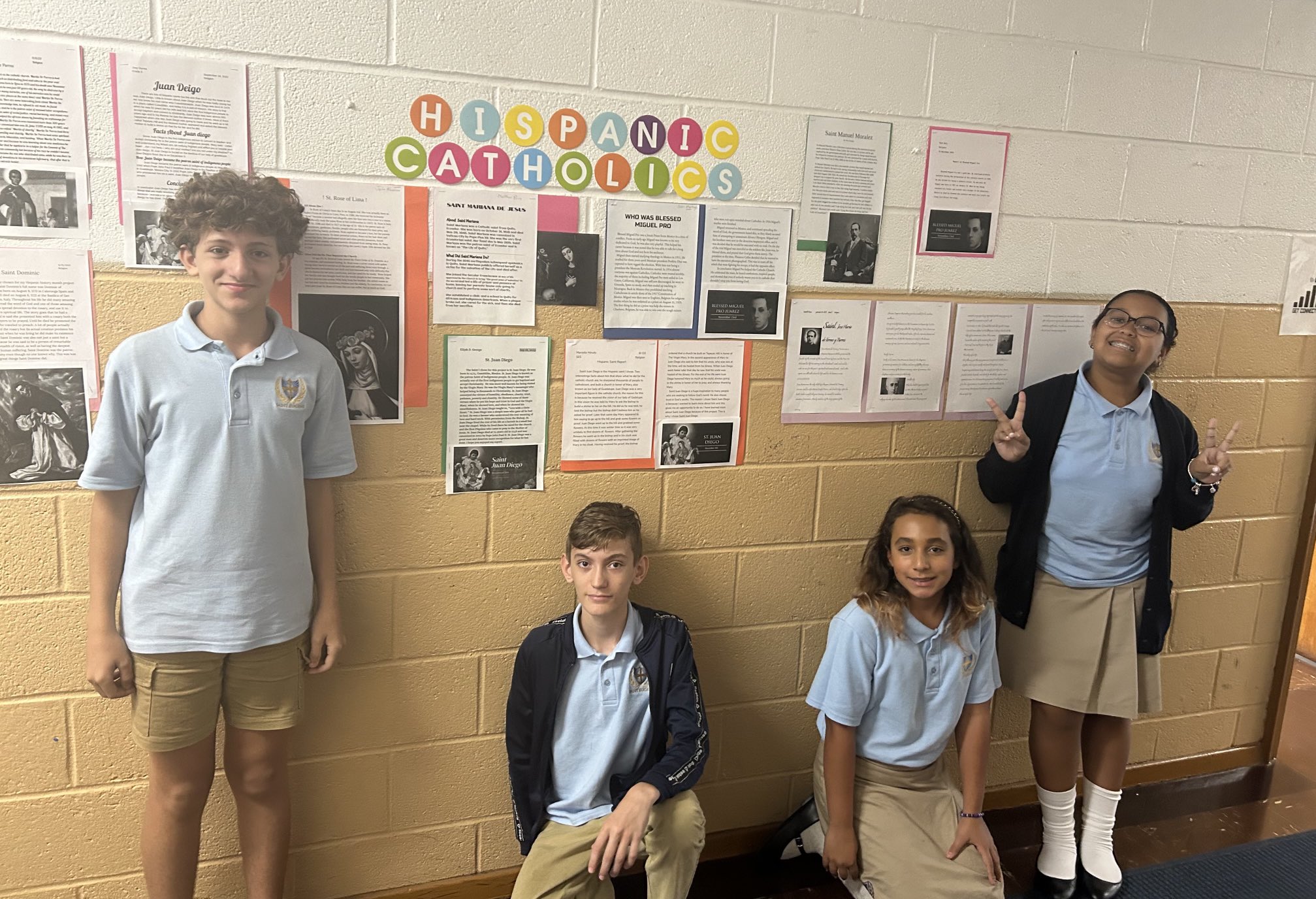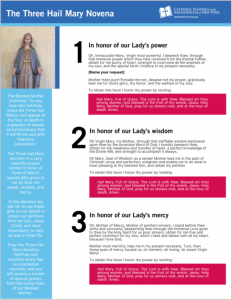Celebrating Our Hispanic Heritage
September 15 marks the start of National Hispanic Heritage Month in the United States. Since 1988, Hispanic Heritage Month has celebrated the rich histories, cultures, and contributions of Hispanic Americans who trace their roots back to Spain and Spanish-speaking countries in North America, Central America, South America, and the Caribbean. On this web page, we are pleased to recognize Hispanic Americans not only in our nation, but also in our schools.
Spotlight On: Our Saints
Catholic School Students Celebrate Hispanic Heritage
Resources and Messages for Families
And to showcase some of the creative ways that our schools are teaching and celebrating Hispanic heritage, persons, and culture, we’ve added our LIVE FACEBOOK FEED to this page, so you can see the many heart-warming examples of Hispanic Heritage in our schools.
Spotlight On: Our Saints
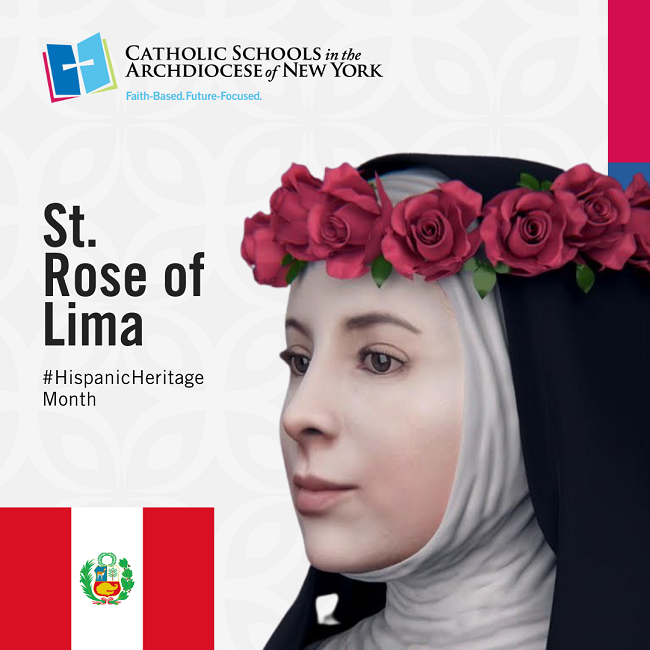 St. Rose of Lima
St. Rose of Lima
Isabel de Flores was born in 1586 in Lima, Peru. Once a maid declared that she looked just like a rose, the name stuck; Isabel even took “Rosa” as her Confirmation name.
As a child, Rosa did not attend school. Instead, she created beautiful needlework which she sold to help her family and raise funds for the poor. Rosa was always attracted to religious life, even deterring suitors by cutting off her hair and rubbing her face with hot peppers. Eventually, she was allowed to join the Third Order of Dominicans. Though Rosa liked to spend her time alone on a hut in her parent’s property, she also opened a free medical clinic for poor children and the elderly in her community. Rosa died in 1617 and was canonized in 1671.
St. Rose of Lima was the first person born in the Western Hemisphere to be canonized. She is the patron saint of Peru and all of South America as well as embroiderers, gardeners, and florists.
Blessed Miguel Pro
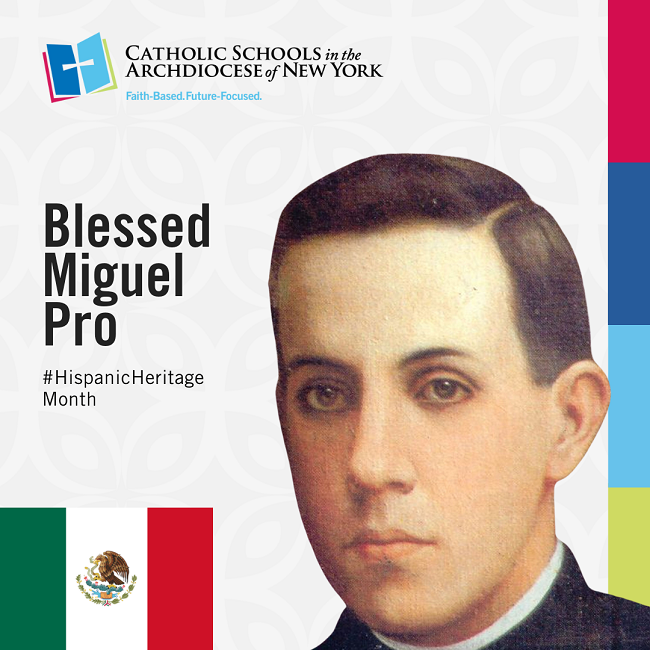 Blessed Miguel Augustin Pro joined the Jesuits in 1909 in Mexico. By 1914, a revolution forced the Jesuits to flee, and he completed his training on the road to Belgium.
Blessed Miguel Augustin Pro joined the Jesuits in 1909 in Mexico. By 1914, a revolution forced the Jesuits to flee, and he completed his training on the road to Belgium.
In 1926, Miguel Pro was sent back to Mexico. Just twenty-three days after he arrived, public worship was banned. Because Miguel Pro was unknown as a priest, he went about secretly celebrating Mass, hearing confessions, distributing communion, and anointing the sick. One year later, Padre Pro and his brothers were arrested and given death sentences on false charges. He and his brother Humberto were executed by a firing squad. Padre Pro refused to wear a blindfold and extended his arms in the form of a cross crying out, “Viva Cristo Rey!” His defiance was celebrated nationwide. Thousands of Mexicans lined the streets to honor him as he was carried in procession to his grave.
Padre Miguel Pro was beatified by Pope John Paul II in St. Peter’s Square in 1988.
St. Junipero Serra
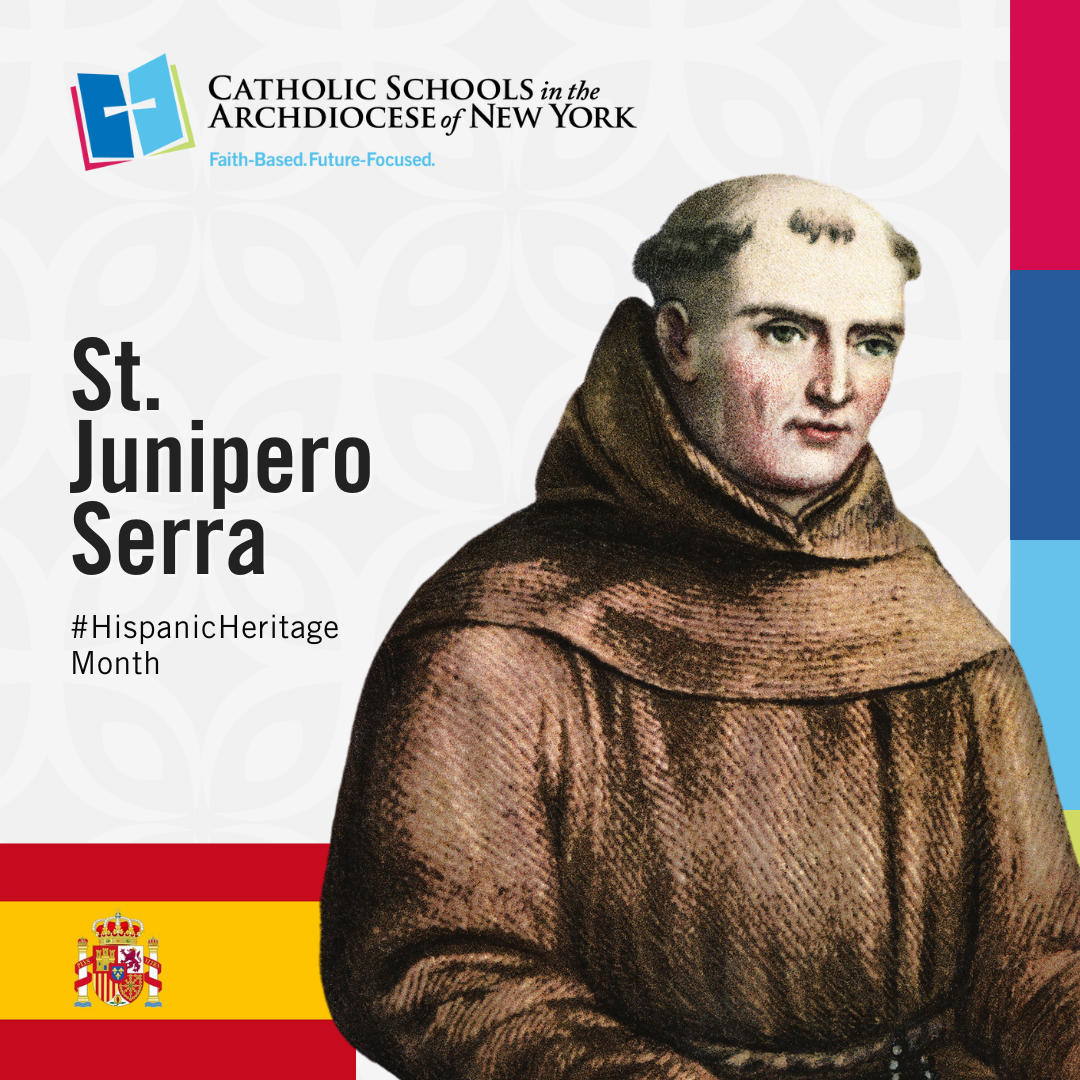 Born in Mallorca, Spain, in 1713, Miguel Joseph Serra Ferrer entered the Franciscan order shortly before his seventeenth birthday. As an academic and later professor of theology, he was known as an intelligent and fair preacher. When Serra heard about the missionary work of others in his community, he gave up his teaching duties and followed his yearning to support missionary efforts in Mexico and South America. Serra later founded the first of nine missions—the Mission of San Juan Capistrano—in what is now California.
Born in Mallorca, Spain, in 1713, Miguel Joseph Serra Ferrer entered the Franciscan order shortly before his seventeenth birthday. As an academic and later professor of theology, he was known as an intelligent and fair preacher. When Serra heard about the missionary work of others in his community, he gave up his teaching duties and followed his yearning to support missionary efforts in Mexico and South America. Serra later founded the first of nine missions—the Mission of San Juan Capistrano—in what is now California.
While the legacy of the Spanish missions today looks more critically at the ways in which Catholicism was imposed on the Native Americans, Serra’s involvement and intentions in California were at least genuine and honest. He led efforts to protect the natives from abuse against Spanish soldiers. Protesting against the cruelty he encountered, he drafted the Representación, a document which laid out the rights of Native Americans in Spanish California and recognized them as Hijos de Dios, or “Children of God.”
Serra died in 1784 and was canonized by Pope Francis in 2015 at the National Cathedral in Washington, D.C.
Saint Teresa of the Andes
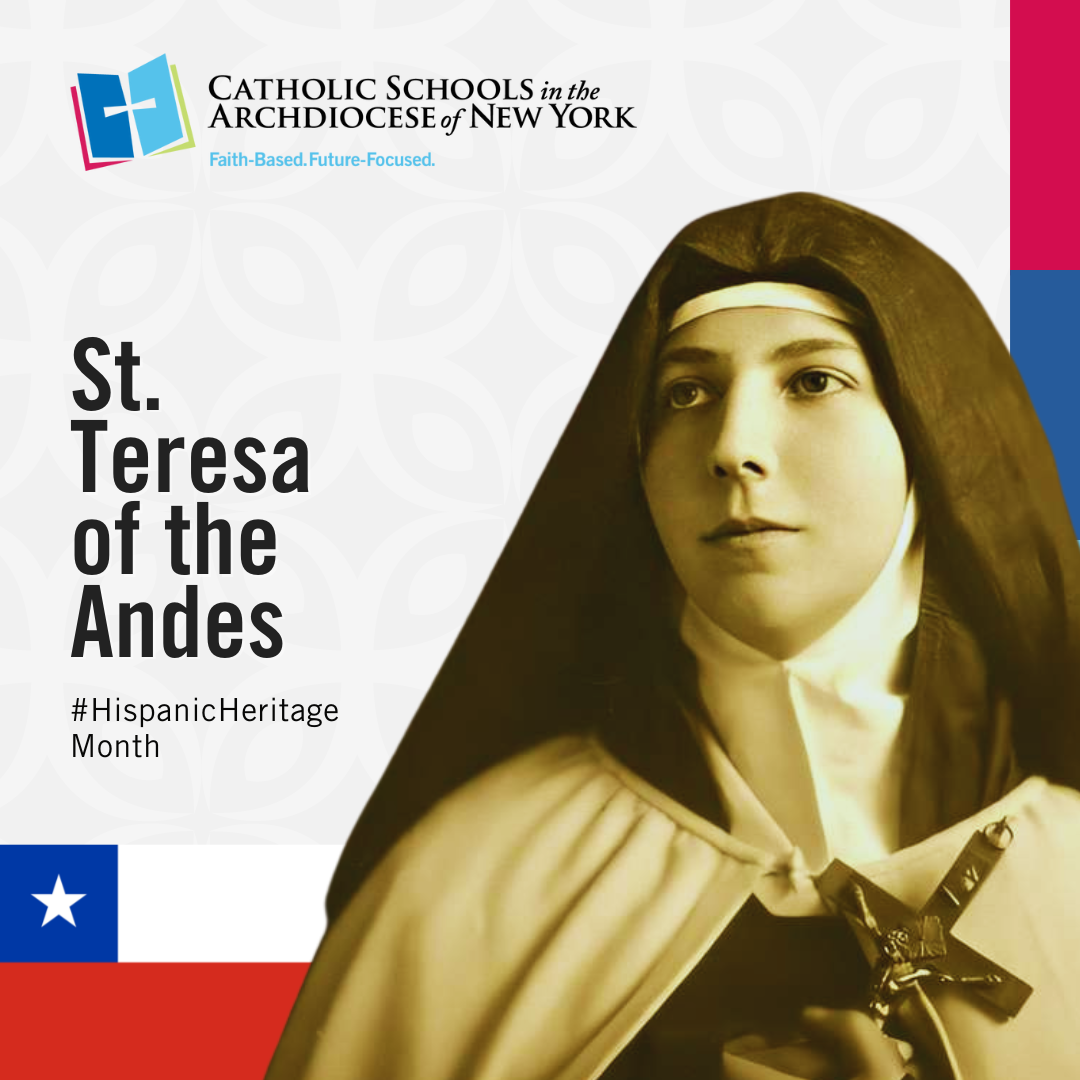 By the example of her life, St. Teresa of Jesus of Los Andes shows us Christ’s Gospel lived down to the last detail. Born in Santiago, Chile, in 1900 and christened Juana Enriqueta Josefina (known as Juanita), she was raised in an upper-class and faith-filled family. As a child, she read the autobiography of St. Thérèse of Lisieux and was profoundly affected by the saint’s life. Juanita chose to live her life in prayer and service to God. In 1919, she entered the Discalced Carmelite convent in Los Andes. After a brief time in the convent, she contracted a fatal illness. Although she was months short of professing her religious vows, she was allowed to do so. St. Teresa of Los Andes died shortly after. Pope John Paul II Canonized her in 1993 making her the first Chilean to be declared a saint.
By the example of her life, St. Teresa of Jesus of Los Andes shows us Christ’s Gospel lived down to the last detail. Born in Santiago, Chile, in 1900 and christened Juana Enriqueta Josefina (known as Juanita), she was raised in an upper-class and faith-filled family. As a child, she read the autobiography of St. Thérèse of Lisieux and was profoundly affected by the saint’s life. Juanita chose to live her life in prayer and service to God. In 1919, she entered the Discalced Carmelite convent in Los Andes. After a brief time in the convent, she contracted a fatal illness. Although she was months short of professing her religious vows, she was allowed to do so. St. Teresa of Los Andes died shortly after. Pope John Paul II Canonized her in 1993 making her the first Chilean to be declared a saint.
Sister Maria Romero Meneses
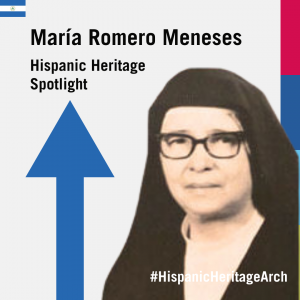 Born in Nicaragua in 1902 to an upper-class family, Maria Romero Meneses was well educated and had a talent for art and music. As a child, she was ill with rheumatic fever, which left her with a damaged heart. Despite this diagnosis, Maria was able to return to school and join the Salesian Sisters of Don Bosco.
Born in Nicaragua in 1902 to an upper-class family, Maria Romero Meneses was well educated and had a talent for art and music. As a child, she was ill with rheumatic fever, which left her with a damaged heart. Despite this diagnosis, Maria was able to return to school and join the Salesian Sisters of Don Bosco.
In 1931, she was sent to San Jose, Costa Rica, which became her second home. During those years in Costa Rica, Maria taught music, drawing and typing to wealthy girls while working with the poor in San Jose. She gave her disadvantaged students practical trades and catechesis while inspiring her wealthier students to help instruct the poor who were isolated and abused.
Throughout her time in Costa Rica, Maria was able to set up recreational centers, food pantries, and a school for poor girls. She died at the age of 75 in Nicaragua on July 7th, which is her feast day, and is buried in the Salesian chapel in San Jose, Costa Rica.
Blessed Ceferino Namuncará
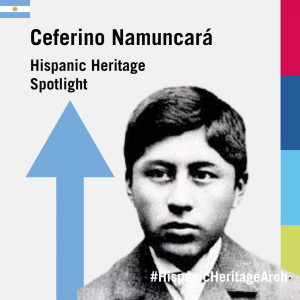 Born in Argentina in 1886 to a leader of the Mapuche tribe, Ceferino’s early years were spent by the Rio Negro River. According to popular legend, he survived a fall into the river. At the age of eleven, Ceferino was sent by his father to study in Buenos Aires. Being the only native at the military training school, he felt mistreated and was unhappy. When transferred to the Salesian college, he felt more comfortable there and fell in love with Don Bosco. Ceferino decided to study to become a Salesian priest in Italy. During his time in Italy, he excelled as a student and as person of prayer. Unfortunately, he died in 1905 from an undiagnosed case of tuberculosis. In 1924, his remains were transferred to his homeland where they are venerated. Ceferino was beatified in 2007 by Pope Benedict XVI. It was the first beatification of a South American indigenous person.
Born in Argentina in 1886 to a leader of the Mapuche tribe, Ceferino’s early years were spent by the Rio Negro River. According to popular legend, he survived a fall into the river. At the age of eleven, Ceferino was sent by his father to study in Buenos Aires. Being the only native at the military training school, he felt mistreated and was unhappy. When transferred to the Salesian college, he felt more comfortable there and fell in love with Don Bosco. Ceferino decided to study to become a Salesian priest in Italy. During his time in Italy, he excelled as a student and as person of prayer. Unfortunately, he died in 1905 from an undiagnosed case of tuberculosis. In 1924, his remains were transferred to his homeland where they are venerated. Ceferino was beatified in 2007 by Pope Benedict XVI. It was the first beatification of a South American indigenous person.
Our Lady of Providence
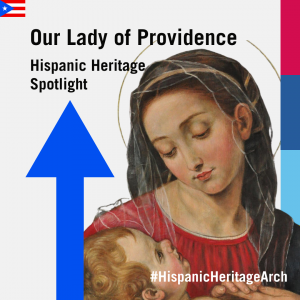 The devotion to Our Lady of Providence was brought to Puerto Rico from Europe in the 1850s by the Servite Fathers.
The devotion to Our Lady of Providence was brought to Puerto Rico from Europe in the 1850s by the Servite Fathers.
Our Lady of Providence is often associated with the Gospel passage of the Wedding Feast of Cana when Mary interceded with Jesus on the newlywed’s behalf. Jesus performed his first miracle of changing the water to wine due to His mother’s intercession. Legend has it that the Servite religious prayed to Mary for help in providing food for the friars. They later found baskets of food outside the door of the friary.
In 1969, Pope Paul VI declared Our Lady of Providence the patroness of Puerto Rico. Her feast day is November 19th.
Our Lady of Altagracia
 Our Lady of Altagracia is the Patroness or Protector of the Dominican Republic. The Dominicans see the image of Our Lady of Altagracia as exemplifying Mary watching over the island and the growth of Christianity there.
Our Lady of Altagracia is the Patroness or Protector of the Dominican Republic. The Dominicans see the image of Our Lady of Altagracia as exemplifying Mary watching over the island and the growth of Christianity there.
While the image of the Virgin de la Altagracia, or “Virgin of Highest Grace,” had long been venerated in Spain, the portrait was brought over to the island prior to 1502 by Spanish brothers Alfonso and Antonio Trejo. Eventually, the portrait was donated to a church, only to be moved to the present basilica in 1971. In 1979, Pope John Paul II crowned the image with a gold and silver tiara enhancing the beautiful frame, which is made of gold, enamel and precious stones.
On her feast day, the entire country honors Our Lady of Altagracia with lively services and festivals. This day, January 21st, is also celebrated as a public holiday.
Saint Juan Diego
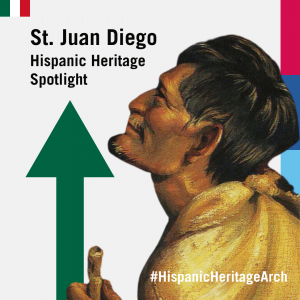 Juan Diego was born in 1474 as a member of the Chichimeca tribe in an area that is now part of Mexico City, Mexico. His indigenous name means “the talking eagle.” Canonized by Pope John Paul II in 2002, his feast day is December 9th.
Juan Diego was born in 1474 as a member of the Chichimeca tribe in an area that is now part of Mexico City, Mexico. His indigenous name means “the talking eagle.” Canonized by Pope John Paul II in 2002, his feast day is December 9th.
Baptized at the age of 50, Juan Diego was walking to morning Mass when the Blessed Mother appeared to him. She asked him to go to the Bishop and request that a shrine be built in her name on the site of her appearance. The Bishop did not believe Juan Diego and asked for a sign. When he returned to the site, the Blessed Mother instructed him to pick flowers. Even though it was winter, Juan Diego found roses flowering. He gathered the flowers and took them to the Blessed Mother who arranged them in his mantle. When he opened his mantle to show the flowers to the Bishop, a dark-skinned indigenous image of the Blessed Mother, Our Lady of Guadalupe, appeared in place of the actual flowers.
As her messenger, Juan Diego helped the indigenous tribes of Mexico embrace Christianity in the largest and most peaceful conversion in the history of the Church. Though his actions reaped great results, he remained humble, living the rest of his life in a small hut near the church built for Our Lady of Guadalupe.
Saint Laura Montoya
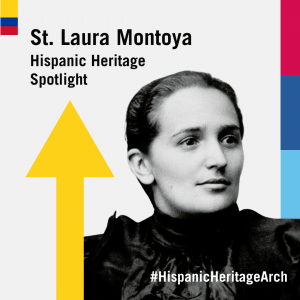 Laura Montoya was a Colombian Roman Catholic religious sister who lived from 1874-1949. As a young teacher, Laura infused Gospel teaching and values with the secular curriculum and acted as a strong role model for the girls she taught.
Laura Montoya was a Colombian Roman Catholic religious sister who lived from 1874-1949. As a young teacher, Laura infused Gospel teaching and values with the secular curriculum and acted as a strong role model for the girls she taught.
In 1914, she and four other young women formed a religious order and headed into the wilderness to live and minister among the indigenous people of Colombia. Despite criticism by many, St. Laura had a desire to eliminate racial discrimination by bringing the love and teachings of Christ to these marginalized people. She wanted to always be present among those who had been looked down upon and ostracized by most Colombians.
In 2013, Pope Francis canonized St. Laura Montoya. She is the first Colombian to be made a saint. For Colombians and Catholics around the world today, Laura stands firm as an example of solidarity, love, community-building, and visionary teaching.
Saint Óscar Romero
 While celebrating Mass on March 24, 1980, the Archbishop of El Salvador St. Óscar Romero was assassinated by a hired gunman. He was then 62. Perceived as a threat against the military regime, whose violence and human rights abuses he spoke out against during his weekly sermons on the radio, Óscar Romero had become targeted for being the “voice for the voiceless.” Not only did he formally denounce the corrupt junta and those supporting it, but he called on his fellow Salvadorans to demand peace and fight for truth and justice.
While celebrating Mass on March 24, 1980, the Archbishop of El Salvador St. Óscar Romero was assassinated by a hired gunman. He was then 62. Perceived as a threat against the military regime, whose violence and human rights abuses he spoke out against during his weekly sermons on the radio, Óscar Romero had become targeted for being the “voice for the voiceless.” Not only did he formally denounce the corrupt junta and those supporting it, but he called on his fellow Salvadorans to demand peace and fight for truth and justice.
His legacy was commemorated by Pope Francis in 2018 when, wearing the same blood-stained belt that St. Oscar Romero was wearing at the altar when he died, canonized him and called him a “martyr for the faith.” Today, Óscar Romero is revered as a symbol of hope for those who have suffered poverty, injustice, and violence.
Saint Narcisa de Jesús Martillo Morán
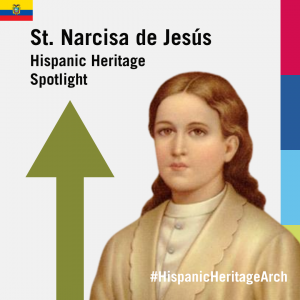 St. Narcisa de Jesús is an Ecuadorian Catholic saint who was canonized in 1992 by Pope Benedict XVI. Her feast day is August 30th. She was born in 1832 in Nobel, Guayas, Ecuador as the sixth of nine children to humble parents with a deep faith. From an early age, she had a love of music and learned to play the guitar. She also had a clear call to sanctity and even converted a small room in her home into a chapel. St. Narcisa moved to Guayaquil in 1852 to help the poor and the sick and to spend more time in prayer and penance. In 1868, she moved to Lima, Peru to live as a lay member in a Dominican convent. She died in December of 1869 at the age of 37 after developing high fevers that lasted for months. The sisters reported that a special and sweet odor filled the room that she died in. St. Narcisa made private vows and kept them faithfully. Her life of purity and piety as well as her work among the poor and sick make her a model of faith.
St. Narcisa de Jesús is an Ecuadorian Catholic saint who was canonized in 1992 by Pope Benedict XVI. Her feast day is August 30th. She was born in 1832 in Nobel, Guayas, Ecuador as the sixth of nine children to humble parents with a deep faith. From an early age, she had a love of music and learned to play the guitar. She also had a clear call to sanctity and even converted a small room in her home into a chapel. St. Narcisa moved to Guayaquil in 1852 to help the poor and the sick and to spend more time in prayer and penance. In 1868, she moved to Lima, Peru to live as a lay member in a Dominican convent. She died in December of 1869 at the age of 37 after developing high fevers that lasted for months. The sisters reported that a special and sweet odor filled the room that she died in. St. Narcisa made private vows and kept them faithfully. Her life of purity and piety as well as her work among the poor and sick make her a model of faith.
Catholic School Students Celebrate Hispanic Heritage
At Our Lady of Victory School, students delved into the world of Frida Kahlo and Diego Rivera, exploring their unique painting techniques and recreating their masterpieces. (Photos: Left: OLV_Frida Kahlo and Right: OLV_Diego Rivera)

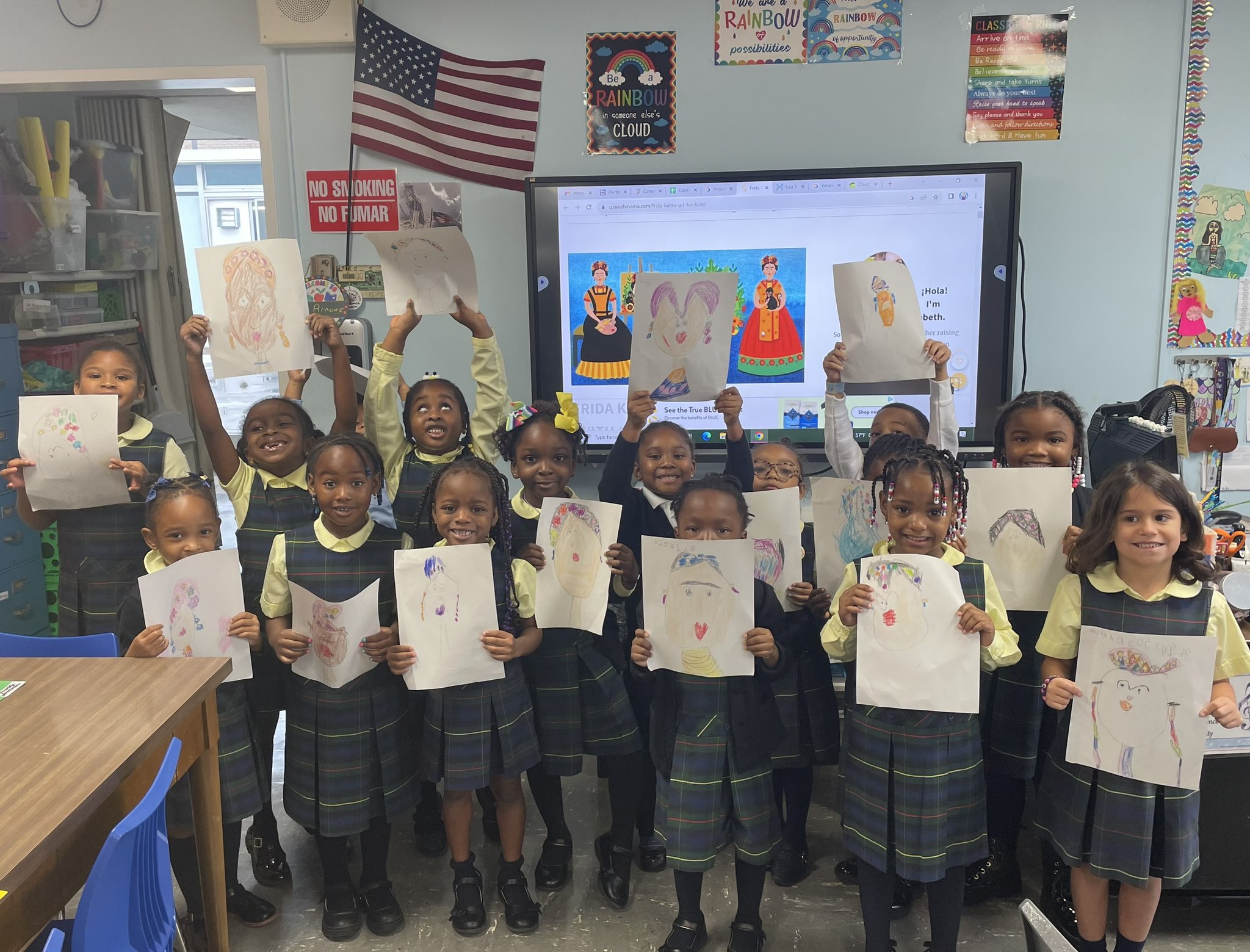
St. Eugene School’s 7th grade class celebrated the contributions of Hispanic Catholics to the Catholic Church with informative and colorful reports. What a fun way to foster cultural appreciation and understanding! (Photo: SES)
After researching Latin American countries, students at Christ the King School in the Bronx put their minds to work on boards showcasing their newfound knowledge of Hispanic Heritage. We love the start of this display!
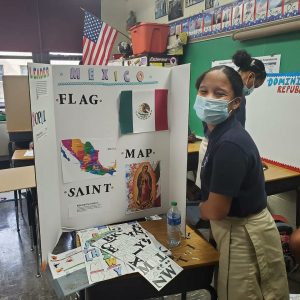
So much fun and educational! The fourth grade of St. Peter Elementary School in Yonkers learning folk dance The Machetes. Click here to view the video!

Resources and Messages for Families
3 Hail Mary Novena
Click here for the English version and here for the Spanish version.




